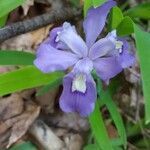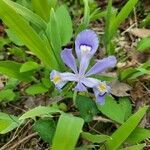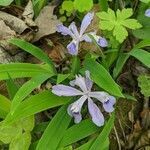Rhizomes producing fleshy roots, and 2–8 cordlike branches at apex, cordlike portion 2–3 dm × 1–2 mm, gradually enlarging to 8–12 mm diam., nodes with brown, scalelike leaves and rarely roots. Stems simple, 2.5–4.5 cm. Leaves: basal 6–8, proximal 2–3 sheathing, blade light brown with darker brown line along midrib at base, falcate, scarious, distal 4–5 not sheathing, blade green or yellowish green, with few, subprominent veins, broadly ensiform, slightly falcate, to 1.5 dm × 1–2.5 cm, enlarging to 4 dm after anthesis; cauline 2–3, sheathing, proximal very similar to basal leaves, distal 1 or 2 reduced, herbaceous, blade falcate, not inflated. Inflorescence units 1–2-flowered; spathes green, sharply keeled, somewhat inflated, 2–6 cm, unequal, outer shorter than inner. Flowers: perianth blue, lilac-purple, or white; floral tube filiform, widening distally, 4–8 cm, lifting expanded portion of flower out of spathes; sepals spreading, with 3 parallel, toothed, crested ridges on white signal bordered with purple, tapering gradually into claw, 3–6 × 1.5–2.5 cm, base gradually attenuate, apex rounded, emarginate; petals spreading, same color as sepals, oblanceolate, 3–4 × 1–2 cm; ovary triangular, with shallow groove along each face, 0.6–1 cm; style 1.5 cm, crests narrowly triangular, 6–9 mm; stigmas oblong, margins entire; pedicel 0.7–1.8 cm. Capsules usually enclosed in spathes, oval, sharply triangular, each angle ridged, 1–1.5 cm. Seeds yellowish brown, 3.2–3.5 mm, smooth, with narrow, white appendage wrapped around seed, 3.4–4 mm, quickly drying upon exposure to air. 2n = 24, 32.
More
Lvs broadly linear, usually somewhat curved-arching, light green, slightly glaucescent on one side, well developed at anthesis, 1–2 dm × 9–25 mm, later elongating slightly; spathe 1–2-fld, the valves rather loosely sheathing each other, the lower ones often spaced on a scape-like stalk; perianth-tube greenish, often streaked with purple or brown, 4–6 cm, much exceeding the spathe, the limb 6–8 cm wide, light violet to lilac or purple, rarely pale or white; sep with a strong, several-ridged, yellow or whitish crest bordered by a white zone outlined in violet or purple, not at all pubescent; pet spreading, oblanceolate, slightly emarginate or blunt, with broad claw; capsule ellipsoid, ovoid, or obovoid, sharply 3-angled, minutely beaked; seeds orange-brown, arillate; 2n=24, 32. Rich woods, banks, and cliffs, in acid soil; Md. to Okla. and Ga. Apr., May.
A small herb. The plant has leaves 15-20 cm high and flowers 10 cm high. It spreads 8-10 cm wide. It has a rhizome which creeps on the surface of the soil. The leaves are curved and sword shaped. Each leaf is 1-2 cm wide and can be 30-60 cm long. The flowers are flattened and 5 cm wide. They are blue with white and yellow.



